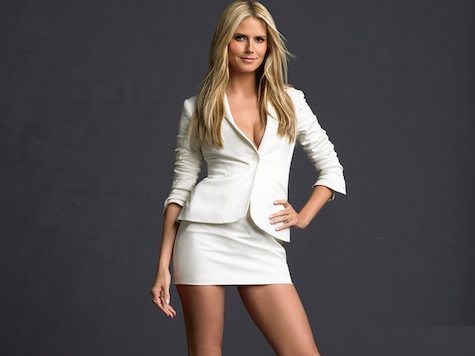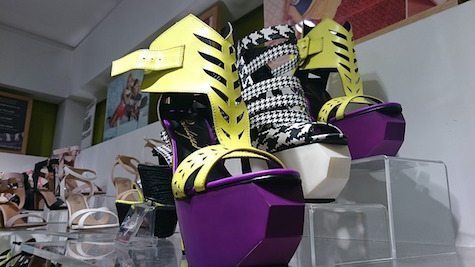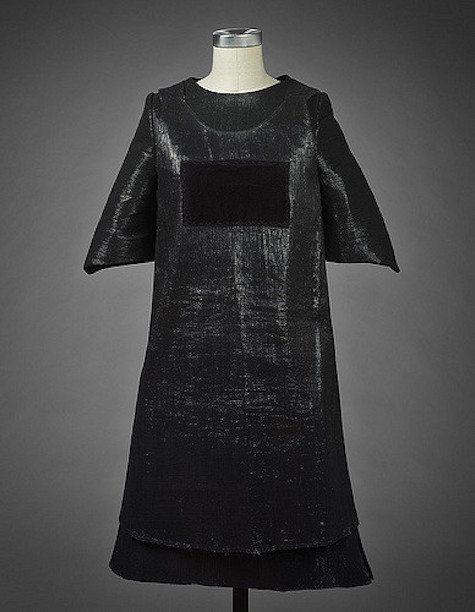Fashioning The Future: Can We Re-Define Fashion?
By RoundPeg | September 20, 2019
This post is part of our Conscious Consumerism series to encourage our readers to live – and buy – responsibly. As marketers in the purpose economy, we see it as our job to help people make purchasing decisions that align with their values and contribute to the greater good. Want to learn more about our mission? Download our Manifesto.
“As you know, in fashion, one day you’re in. And the next day, you’re out.”
This is what Heidi Klum, the host of fashion-design-competition-meets-reality-TV-show Project Runway, tells competitors every week. Heidi is a model, designer and businesswoman so I’m sure she knows how fashion works, but our question is this: is this the only way fashion can work?
Make It New

Heidi Klum’s catchline on Project Runway is “One day you’re in. The next day, you’re out” – not a very sustainable perspective.
Immanuel Kant was the first fashion theorist to emphasize newness as an essential quality of fashion. Prior critics viewed fashion as the pursuit of beauty but for Kant, it was “the principle of novelty that enlivens fashion and lends it its special charm.” And indeed, we do love the new.
Chasing newness is an infinite quest because objects lose their novelty so quickly – something else will always be newer. This continual quest for the new is what’s shaped the fashion landscape and created “fashion cycles.”
Traditionally, fashions move in cycles, with a fashion cycle resembling the adoption curve in tech: there’s a time when a style is embraced by only fashion-forward “early adopters,” a time when it has mass appeal and a time when it’s rejected for the next big thing. As Heidi would say, one day the style is in, the next day it’s out.
The critical difference between fashion and tech is that in the case of technology, new developments render old systems insufficient, inefficient or obsolete. In fashion, perfectly useful things move into obsolescence based on the irrational logic that exalts a new aesthetic. The item’s lifespan isn’t determined by how long it’s useful or functional but by how long it’s “in fashion.” From a sustainability perspective, this is essentially abhorrent.
Did you know that meaningful brands have outperformed the stock market by 206%?
Get free access to the latest research & data that prove how Purpose will drive your company’s success:
In the eighteenth century, a fashion could last a decade or more and it was clear when a style was outdated. Modern manufacturing and supply chains have accelerated the velocity of fashion cycles, giving rise to the “fast fashion” phenomenon. Since no one can dream up authentically new styles at a rate that keeps pace with contemporary fashion seasons, designers recycle old ideas with such speed that functionally, fashion cycles overlap. Consumers are inundated with reincarnated styles in cycles so rapid that “in” and “out” become incomprehensible.
If now nothing can be “out” and if the development of genuinely “new” styles has been virtually abandoned, why are we still buying so many new clothes?
Why Buy?

Distinctive styles serve as barriers (I’m different than you people wearing loafers) and bridges (I’m like you cool kids with purple heels).
According to anthropologists Mary Douglas and Baron Isherwood, the primary function of fashion is identity creation. We use our clothing as a series of signs to establish our identities and affiliations – as barriers and bridges. If you wear a cool leather jacket and Doc Martens and dye your hair blue, you’re aligning yourself with other punks (bridge) and separating yourself from mainstream people with “normal” hair and polo shirts and khakis (barrier). Of course a style in a vacuum doesn’t mean anything, but in context it communicates affiliation.
We keep collecting the items necessary to express our identities. We’re multi-faceted, complex and ever-evolving, so the job of constructing ourselves through fashion symbols is never done. What’s more, the thrill of the chase keeps us engaged and entertained. So even though the velocity of cycles means that nothing we own is really “out” of fashion, we still go through the motions.
What does the future hold?
We’ve written previously about the evolving set of values the general consumer population holds dear and pointed to an increasing concern for the environment and sustainable living. If this is how more and more wearers of clothes identify themselves – as conscious consumers – what will that do to fashion as we know it? (Click to Tweet!)
There are developments within the existing paradigm of fashion that speak to these concerns and hint at a more hopeful, but still fashionable, future:
- There are Cradle-to-Cradle (C2C) jeans like those made by B Corp Mud Jeans. Consumers can swap jeans out for a different pair and old jeans are recycled into new denim.
- More sustainable fabrics are gaining traction. Single-fiber textiles that are easier to recycle are becoming more popular as are fabrics like those produced by B Corp Thread, which are made from recycled plastic. Demand is also growing for sustainably and organically grown cotton, like the kind B Corp Tuckerman & CO uses, and for fabrics dyed without harmful chemicals.
- Companies like B Corp Patagonia are designing clothes that are meant to last and helping consumers make them last longer.
- Clothing rental companies allow multiple people to use a single garment, usually one that’s needed for a special occasion.
- Buying used is gaining popularity, even among high-end shoppers.
- Companies are exploring “closing the loop.” One example is B Corp Eileen Fisher, whose Green Eileen program offers customers a $5 credit for each Eileen Fisher item they return to a store to be resold or recycled. Proceeds made from resoled garments go to the Eileen Fisher Community Foundation, which supports leadership programs for women and girls.
These steps are HUGE in and of themselves, but we wonder if they’re just the beginning of a new era. What if, in an effort to curb waste and promote sustainability, we could redefine fashion? What if the essential quality wasn’t newness and the desire for ornament and change could be subsumed by something else? What if the essential quality was consciousness?
Planned obsolescence would become obsolete. Every fashion would be designed and engineered to be as appropriate and attractive and comfortable as possible for as long as possible in as many situations as possible. Perhaps a dress would transform gracefully into a skirt, doubling the utility of a single garment. Maybe fit would be more fluid to allow for relatively minor fluctuations in the weight of the wearer.
Part of you might be screaming: What about originality? Style? Artistry? FUN?!?! Yet consciousness-driven fashion still allows for these things. Look at the fine artists that have incorporated sustainability considerations into what materials they use and where they place their work. Look at all of the amazing things they make from found items and cast-offs. Of course fashion made in this way couldn’t be mass-produced but it certainly allows for creativity in the haute-couture world.
Maybe for the consumer, the fun of fashion becomes finding ways to alter a look sustainably. Maybe garments become infinitely customizable and mutable. Maybe sharing, renting and buying used become the norm. Maybe consumers will buy a garment and then pay for supplemental, eco-friendly upgrades to keep their look fresh. Could one shirt replace the need for two different shirts if it was constructed with one color on the outside and one on the [other] outside? Could self-cleaning clothes eliminate the need for so many garments by keeping all clothes usable and out of the “dirty, waiting to be washed” pile?
It’s impossible to tell what the future of fashion looks like, but it’s clear that our current predicament is more than irrational – it’s unsustainable and it’s not aligned with emerging social values. Do you think it’s possible to redefine fashion? Which approaches do you think will gain traction? What are your favorite companies that are doing fashion differently? We’d love to hear your thoughts in the comments below.
*The ideas here draw heavily on chapters two, three and seven of the book Fashion: A Philosophy by Lars Svendsen. If you’re ready for a deep dive into fashion theory, we can’t recommend it enough.
This post was originally published on May 11th, 2016 and updated on September 20th, 2019.




